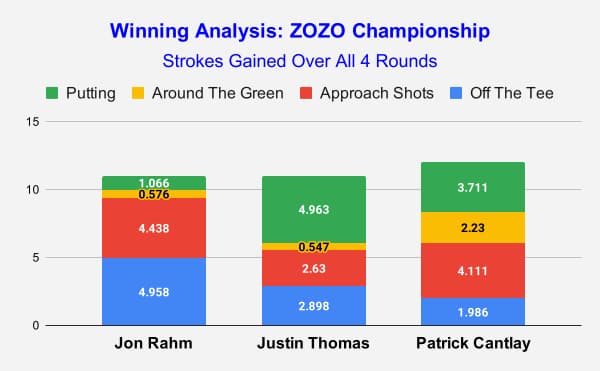Winning Analysis: Patrick Cantlay at The ZOZO Championship
A weekly series that analyzes how the latest PGA TOUR winner separated himself from the field, and in particular from the player(s) who came in second. What was the strongest part of his game? How did he stack up in each aspect versus his peers? Is there a pattern to success on the TOUR?
Patrick Cantlay won the ZOZO Championship last week with a score of 23 under par, beating Justin Thomas and Jon Rahm by a stroke. Going into the final round, he trailed Justin by 3 strokes and Jon by 2, but shot a 65 to win by one over the two players.
We examined strokes gained data from all four rounds across four categories (Off-The-Tee, Approach-The-Green, Around-The-Green, and Putting). All three players gained strokes over the field in each category, and the data clearly identified each player’s strengths — Jon Rahm’s ball striking, Justin Thomas’ putting, and Patrick Cantlay’s approach shots and short game.
We compared the players’ final round performance, and the attached charts highlight Patrick’s comparative advantage in putting in that round as the biggest contributor to his comeback victory from 3 shots behind.
At the elite level of the PGA TOUR, players have to be above average across most facets of the game just to be in contention, and significantly outperform in one or more categories to win. Patrick Cantlay ranked number 1 in scrambling, getting up and down 16 out of 18 times in the tournament. He did not 3-putt even once, and attributed the work he put in over the past few weeks to his success on the greens. A hot short game on top of good ball striking was a recipe that worked for him this week.
So what does this mean for the average amateur golfer? The biggest difference between pros and amateurs is in distance off the tee and in approach shots to the green, which suggests that amateurs work on their full swing for sustainable improvement. This requires time and effort, and is most effective when there is an experienced teaching professional to coach the player. We submit that a longer lasting coach-player partnership is much more fruitful than a one-off lesson.
In business and at the workplace, many people attribute having a mentor as key to their career success. Why don’t we take the same approach to golf instruction? Statistics can tell a player what aspect of the game to work on, but a coach can tell you how to improve.

